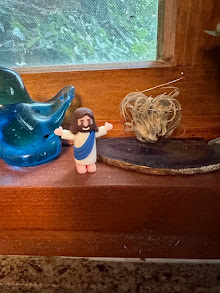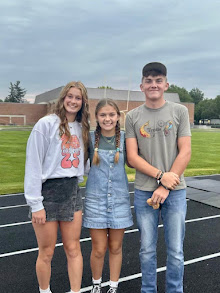"GO WEST, YOUNG MAN, GO WEST" was an expression first used by John Babsone Lane Soule in the Terre Haute Express in 1851. It appealed to Horace Greeley, who rephrased it slightly in an editorial in the New York Tribune on 13 July 1865: "Go West, young man, and grow up with the country."

In the '80s, (20th century vintage) the Hurst family took these words to heart and set our sights on the sunset. We were growing too. By the time we loaded two coolers, two suitcases, three duffle bags, two backpacks, a tote of hardbacks and travel guides, two grocery sacks of bread, chips and cereal, a Tupperware container of chocolate chip cookies, a camera bag with 10 rolls of film, towels, pillows, one sleeping bag at least....am I forgetting anything else? Well, by the time the Econoline backed out onto 150th and spun the first gravel on its westward trek, it was full to the gunwales and testing the springs on its back end. Ben would be nearly out of earshot on the back bench seat while his older sisters expressed their seniority by occupying the captain's chairs amidships. Blake and I had our Casey's go cups full of home brew, a plastic bag of cassette tapes behind the console and a stack of paperbacks and travel books just behind the front seat where we could easily retrieve them...that is, until the entire leaning tower capsized around the first sharp curve or first sudden stop.

But we had miles to go before we slept, 430 of them on I-80 across Nebraska. Like the pioneers we followed the waters of the Platte as it wallows its way across the state. Where does the West begin? Cozad, Nebraska gives the imaginary line co-star billing just under its name over the myriad steel ribbons that have connected the concrete skyscrapers across the state since 1868. A visit to these western Nebraska towns with their wide and dusty streets is a reminder that the 100th meridian is also the dividing line between humid and arid for dryland agriculture. West of Cozad and its ilk, less than twenty inches of rain is all that can be expected. In this drought year of 2012 I have an intimate affinity with the consequences of white hot burning skies for days on end. As dust from hundreds of hooves and wheels choked the noses and scratched the eyes of the pioneers, its no wonder they bypassed the lands of Nebraska and took their chances over the mountains.

Our prairie schooner was nearly as self contained as the Conestogas. We kept our eyes peeled for the relief of shade and water for picnic lunches and room to stretch and run. The long ribbon of I80 provided respite at sun bleached rest areas where we honed our skills and imaginations attempting to identify the slabs and curls of metal labeled as public 'art'. Fort Kearney offered a compound, a trail to a wooden bridge over the Platte, a soddie hut, and shady tables near gurgling irrigation ditches.

But the West can hardly begin where corn rows still border the highways. No, the Ford Econoline entered the West somewhere past Buffalo Bill Cody's iconic Scout's Rest, shrine to the Wild West Show and its creative genius. Somehow, between the rising plains and the lowering skies, between the pinnacle of Chimney Rock and the Wyoming line, as the traffic thinned on the highways and human habitations hugged the life lines of cottonwoods, the view from our twentieth century conveyance merged seamlessly with the dust clouds of history becoming one with the Oregon Trail.
The pioneers probably didn't think they had it easy trudging the hundreds of miles alongside the Platte. But the barriers of Windlass Hill and Scott's Bluff were harbingers of the hard work to come. If a landmark bears your name in the West, you can assume you came to a bad end. Scott's Bluff is named for mountain man Hiram Scott, whose bones were discovered when spring arrived at the foot of the bluffs. No good mountain man deceases without a legend and Mr. Scott showed a lot of life after his death. In one version, a sickly or injured Scott was left behind by comrades on the north side of the Platte. The next spring, his bones were found near the Bluffs...on the opposite side of the river. Later tales have the ailing mountain man surviving a winter trek of sixty miles before succumbing at the foot of the Bluffs, and, finally,one recounting makes the pathetic Mr. Scott drag himself over a hundred miles to reach his resting place at the foot of his namesake outcropping.
 Nothing so arduous or ghastly for the Hursts, but we have our own history with this outpost of western Nebraska. Way back in the dirty '30s, my grandfather, a civil engineer and bridge builder, worked on the road and tunnel to the top of Scotts Bluff; part of the federal works programs of the Depression years. This piece of pavement was the first concrete road in the state of Nebraska, by some accounts. I have a mental picture of my grandmother traveling by train out west....has someone told me this, or is it just a product of my imagination? Visions aside, my mom was born in Scotts Bluff back in 1933 and lived there until she was three. They came back east in 1936, a year that has been much on our minds in 2012.
Nothing so arduous or ghastly for the Hursts, but we have our own history with this outpost of western Nebraska. Way back in the dirty '30s, my grandfather, a civil engineer and bridge builder, worked on the road and tunnel to the top of Scotts Bluff; part of the federal works programs of the Depression years. This piece of pavement was the first concrete road in the state of Nebraska, by some accounts. I have a mental picture of my grandmother traveling by train out west....has someone told me this, or is it just a product of my imagination? Visions aside, my mom was born in Scotts Bluff back in 1933 and lived there until she was three. They came back east in 1936, a year that has been much on our minds in 2012.The Oregon Trail sites come hard and fast right across the Wyoming line. Near Guernsey, Wyoming, the thousands of wagon wheels wore ruts two to six feet deep in the soft sandstone and emigrants incised their names and dates on the Register Cliff, the easternmost example of pioneer graffiti. One hundred eighty miles, or maybe nine days away, was Independence Rock, a humpbacked granite outcropping in a part of Wyoming that even today feels isolated. The Hurst family arrived at the landmark one cool mountain morning, cruising silently through the valley of the Sweetwater past the Rattlesnake Mountains, the Antelope Hills, and miles of the Pathfinder Ranch. As pioneer children undoubtedly did, our kids clambered over the rough granite and searched for historic inscriptions. Alas, granite is considerably harder to carve than sandstone; the pioneers wrote on the Rock with paint, wagon tar, or a concoction of buffalo grease, black powder and glue and little remains of their notations. With their eyes on posterity, the Mormons stationed a carver at the rock to carve travelers' names for a fee. We were content to record our presence with photographs.
Our western odyssey that year eventually crossed South Pass itself and wound its way through the Rockies to the most iconic of all Western landscapes, Yellowstone National Park. Making our way along the boardwalk to Old Faithful, we not only notched our pistols with a landmark memory but paid homage to all those travelers, whether Pullman car sightseers or travel and bone weary emigrants who had passed over the rails and trails for a hundred and more years before us. Unless you make your way across this magnificent nation, unless you take the time to read the historic markers, walk the trails, stop at the waysides without plumbing, and take the time to visit the local museums in the windblown small towns, you cannot begin to comprehend the leaps of faith and foolishness our predecessors made in traversing the forbidding distances and terrain of the western US. There is still empty space out there, not just the breath taking wilderness of the high country, but the formidable physical and spiritual barriers of weather, horizon, aridity and loneliness.

Can we instill an appreciation or sense of wonder in a one week vacation? Can we pursue our past across the country and hope to catch even an inkling of the people of that time and country? Can we plant a passion for our nation's history and our ongoing responsibility in it?
A tall order, but we Americans have seldom backed down from the big picture.
Westward HHHOOOOOOOOOOOOooooooooooooo.!





















No comments:
Post a Comment